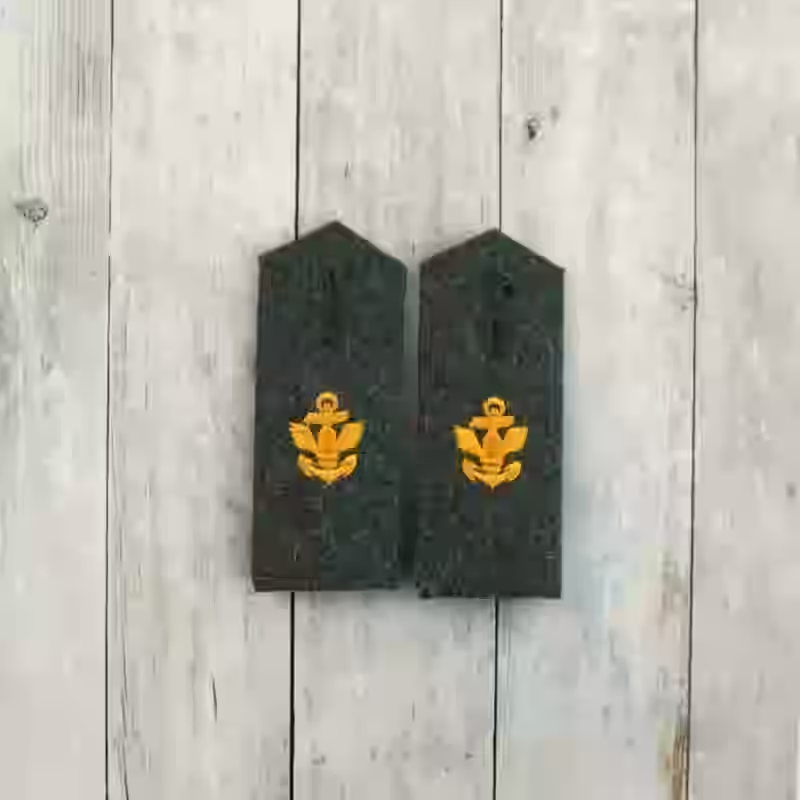
Kriegsmarine Coastal Artillery Enlisted Men's Shoulder Boards M40
14.00 €
Enhance your historical collection with these Kriegsmarine M40 coastal artillery enlisted men’s shoulder boards, a meticulously crafted WWII German military collectible. Featuring a yellow thread-embroidered anchor emblem on a feldgrau wool background, these shoulder boards were worn by enlisted personnel of the Kriegsmarine’s coastal artillery units. Designed for the M40 uniform, they reflect the disciplined aesthetic of Nazi Germany’s navy during World War II. Below, we explore their historical significance, material composition, and enduring value for collectors and historians.
Historical Background
The Kriegsmarine M40 coastal artillery shoulder boards were worn by enlisted personnel of the Kriegsmarine, the naval branch of the Wehrmacht, from 1935 to 1945. Specifically designed for the coastal artillery units, these boards were used by ranks such as Matrose (Seaman) to Obermaat (Petty Officer) responsible for operating anti-ship artillery and heavy fixed guns in coastal fortifications. Introduced with the M40 uniform, these shoulder boards were a standard feature for coastal artillery personnel, who played a critical role in defending Germany’s coastlines and occupied territories, including fortifications along the Atlantic Wall and Baltic Sea.
The yellow anchor emblem, a symbol of naval tradition, distinguished coastal artillery units within the Kriegsmarine, signifying their specialized role in maritime defense. Unlike the Kriegsmarine’s shipboard personnel, who often wore blue-based insignia, coastal artillery units used feldgrau (field-grey) backgrounds to align with their land-based operations alongside Wehrmacht Heer units. These Kriegsmarine insignia were integral to uniforms during key WWII campaigns, such as the defense against Allied landings and naval bombardments, embodying the Kriegsmarine’s strategic importance in the Third Reich’s war effort.
Material & Condition
These Kriegsmarine shoulder boards are crafted from feldgrau wool, with a machine-embroidered yellow cotton thread anchor emblem, symbolizing coastal artillery service. Measuring approximately 4.5 cm wide by 11 cm long, they are designed to be sewn onto the shoulders of M40 Kriegsmarine tunics. The machine-embroidery technique, prevalent from 1935 to 1945, ensures a durable, clearly defined anchor with tightly woven threads. The boards feature a stiff inner lining for structural integrity, with edges typically reinforced with stitching to withstand field conditions.
Authentic period pieces may show signs of wear, such as slight fading of the feldgrau wool, minor fraying of the yellow thread, or wear on the stitching from prolonged use. Collectors should distinguish originals from reproductions, which may feature overly uniform embroidery or synthetic materials. Genuine shoulder boards often exhibit subtle imperfections, such as slight variations in anchor design or thread tension, reflecting wartime production by German textile workshops. These characteristics make the shoulder boards a prized historical German artifact for those seeking authenticity.
Collector’s Insight
The Kriegsmarine M40 coastal artillery shoulder boards are highly valued as Third Reich memorabilia due to their rarity, historical significance, and connection to the Kriegsmarine’s specialized coastal artillery units. Their association with the defense of key WWII fortifications, such as the Atlantic Wall, makes them a focal point for collectors of WWII German military collectibles. The yellow embroidered anchor and feldgrau wool background further enhance their appeal as a testament to wartime naval craftsmanship.
These shoulder boards attract military historians, museum curators, and reenactors seeking period-accurate uniform components for educational displays. Given their sensitive historical context, collectors are urged to handle this artifact with respect, using it to educate about the complexities of WWII rather than glorifying the associated ideology. For preservation, store the shoulder boards in an acid-free, archival-quality sleeve or display case to protect against moisture, UV light, and fabric degradation. Displaying these Kriegsmarine insignia in a museum-quality shadow box with historical documentation enhances their educational value, offering a tangible link to a pivotal and tumultuous era.
Historical reproductions only. Janoor Militaria does not endorse the ideologies of Nazi Germany or any extremist groups.